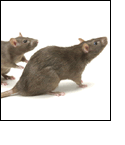Return to Online
Education Kit
|
 |
 |
 Previous Event | Next Event Previous Event | Next Event 
2004: Rat and Chicken Genomes Sequenced

An international group of scientists supported by the National Institutes of Health produced a high quality draft sequence of the genome of the laboratory rat. The rat’s is the third mammalian genome to be sequenced after human and mouse. The rat has been helping scientists understand human biology for nearly 200 years. Now the rat genome sequence promises to improve the utility of this important model organism. The genome has 2.75 billion bases, slightly larger than the mouse genome of 2.6 billion bases and has approximately the same number of genes as the mouse and human genomes (20,000—25,000). The new analysis confirms that the rodent lineage split 12 to 24 million years ago into separate lines that gave rise to the rat and the mouse. Although rats and mice look similar to each other, there are significant differences between them at the genetic level. For example, rats possess some genes not found in the mouse such as ones associated with immunity, pheromone production, protein degradation, and detoxification of chemicals.
In a separate effort, a research team at Washington University School of Medicine in St. Louis assembled a draft sequence of the ancestor of domestic chickens. This sequence was used by an international group of scientists to compile a map of genetic variation among three different strains of domestic chickens. The genome sequence of the chicken is important not only because of its economic value as a source of meat and eggs but also because it is used as a research model for studying embryology and development. Recent outbreaks of avian flu have heightened interest in the chicken sequence. Scientists hope to use the sequence data to learn how genetic variation contributes to susceptibility to the disease.
More Information
References:
Gibbs, R.A., Weinstock, G.M., Metzker, M.L., Muzny, D.M., Sodergren, E.J., et al. Genome sequence of the brown Norway rat yields insights into mammalian evolution. Nature, 428: 493-521. 2004. [PubMed]
International Chicken Sequencing Consortium. Sequence and comparative analysis of the chicken genome provide unique perspectives on vertebrate evolution. Nature, 432:695-716. 2004.[PubMed]
International Chicken Sequencing Consortium. A genetic variation map for chicken with 2.8 million single-nucleotide polymorphisms. Nature, 432: 717-722. 2004. [PubMed]
 Previous Event | Next Event Previous Event | Next Event 
Last Updated: April 7, 2008
|

